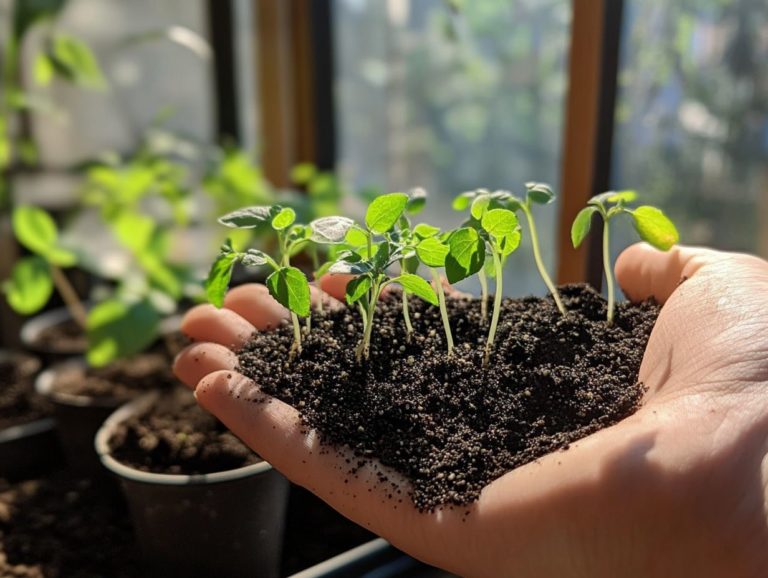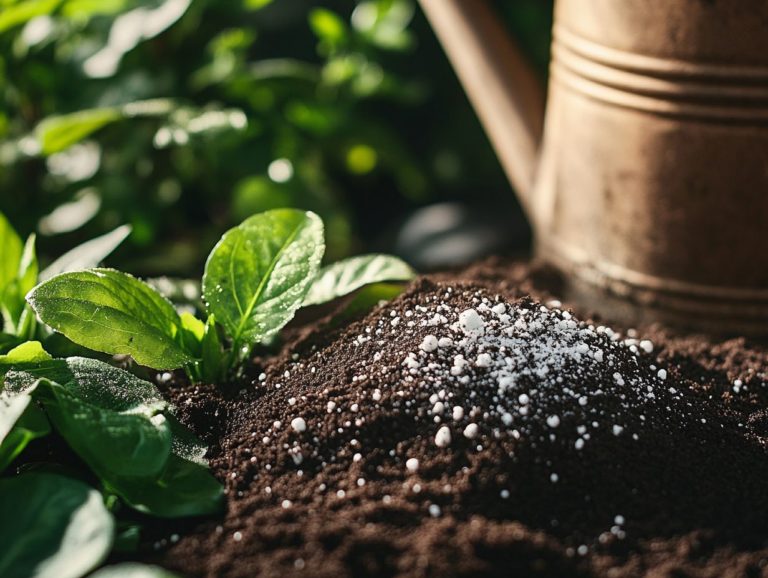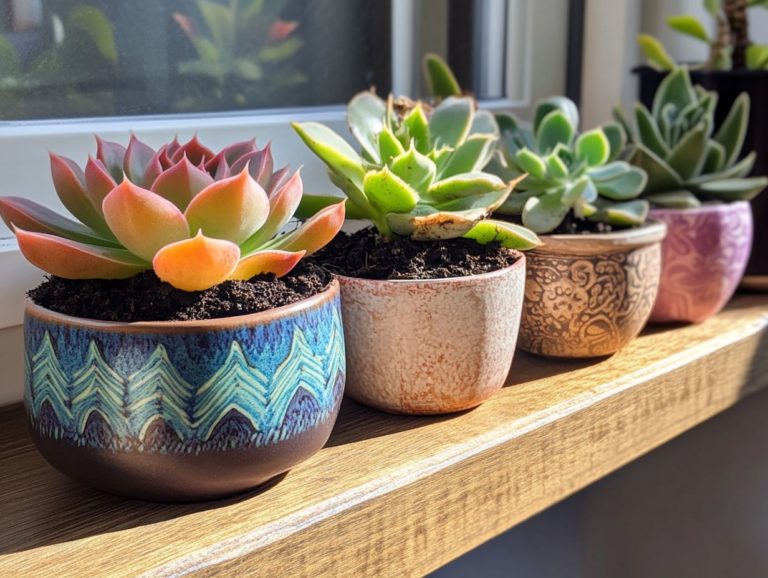How to Create a Balanced Fertilizer
In your quest for vibrant, flourishing plants, grasping the importance of balanced fertilizer is essential.
A balanced fertilizer is vital for optimal plant growth. It breaks down nutrient needs into both macronutrients and micronutrients that your plants crave. This article delves into the components of a balanced fertilizer, guiding you on how to select the perfect one for your garden. You’ll also discover best practices for applying fertilizer and how to monitor nutrient levels. This knowledge will help your plants not only survive but thrive.
Get ready to unlock the secrets of cultivating vibrant and robust plants!
Contents
- Key Takeaways:
- The Importance of Balanced Fertilizer
- Understanding the Nutrient Needs of Plants
- Components of a Balanced Fertilizer
- Choosing the Right Fertilizer for Your Plants
- Creating Your Own Balanced Fertilizer
- Applying Balanced Fertilizer
- Monitoring and Adjusting Fertilizer Levels
- Frequently Asked Questions
- What is a balanced fertilizer?
- Why is it important to create a balanced fertilizer?
- How do I determine the nutrient needs of my plants?
- What are the essential nutrients for plant growth?
- What are the different types of fertilizers that can be used to create a balanced fertilizer?
- How can I create a balanced fertilizer at home?
Key Takeaways:

- A balanced fertilizer is your secret weapon for vibrant plant growth and flourishing health.
- Understanding the nutrient needs of your plants, including both major and minor nutrients, is crucial for creating a balanced fertilizer.
- Factors such as plant type, soil conditions, and growth stage should be considered when choosing and applying fertilizer to ensure the right nutrient balance.
The Importance of Balanced Fertilizer
Balanced fertilizer is essential for optimal plant nutrition, offering a harmonious mix of vital nutrients required for robust growth. It includes key elements like nitrogen, phosphorus, and potassium (NPK), each playing a pivotal role in various functions within plants.
These nutrients support healthy root development and foster chlorophyll production. They boost overall vitality, making balanced fertilizer a necessity not only in sustainable gardening practices but also in commercial agriculture.
By recognizing the significance of these nutrient components, you can elevate your plant care routine and contribute to environmental sustainability through effective organic solutions.
Why a Balanced Fertilizer is Necessary for Plant Growth
A balanced fertilizer is crucial for your plants growth, providing the essential nutrients they need at various stages of development and for their functions.
Nitrogen, phosphorus, and potassium are key players in this nutrient trio. Nitrogen promotes lush foliage, ensuring your leaves stay vibrant and productive. This enhances photosynthesis.
Phosphorus is essential for strong root development and encourages flowering. Just look at tomatoes without sufficient phosphorus, they end up with stunted roots and diminished fruit yield. On the other hand, potassium boosts your plants’ overall resilience, helping them manage water efficiently and fend off diseases.
Research has shown that lacking these essential nutrients can lead to poor growth and unproductive plants, showing just how important a solid fertilization plan is. Prioritizing balanced nutrition will set you and your plants up for success.
Understanding the Nutrient Needs of Plants
Grasping the nutrient requirements of plants is essential for attaining peak growth and yield. This understanding includes both major nutrients and minor nutrients, each playing a distinct and vital role in the realm of plant nutrition.
Macronutrients and Micronutrients
Major nutrients and minor nutrients are essential for your plants nutrition. Major nutrients, such as nitrogen, phosphorus, and potassium (often referred to as NPK ratios), are required in larger quantities to support fundamental metabolic processes.
These nutrients each play specific roles in your plants growth and development. They drive crucial functions like photosynthesis, energy transfer, and the formation of cellular structures. For example, nitrogen is vital for creating amino acids and proteins. Phosphorus is key for strong root development and vibrant flower formation.
Minor nutrients, though needed in smaller amounts, are just as important. Elements like iron and zinc enhance enzyme function and promote chlorophyll production. If your soil lacks these essential nutrients, your plants may suffer from deficiencies, resulting in stunted growth, yellowing leaves, and reduced yield.
Therefore, ensuring the availability of nutrients in the soil is critical for achieving optimal plant performance.
Components of a Balanced Fertilizer

The components of a balanced fertilizer prominently feature nitrogen, phosphorus, and potassium, typically represented in NPK (nitrogen, phosphorus, potassium) ratios. These ratios determine the fertilizer’s nutritional profile and guide you in selecting the most suitable option for your specific plants.
Nitrogen, Phosphorus, and Potassium Ratios
NPK ratios represent the precise proportions of nitrogen, phosphorus, and potassium in a balanced fertilizer. They serve as your essential guide for plant care and ensure an optimal nutrient balance.
Understanding these ratios is vital for gardeners who aim to meet their plants specific nutrient needs. For example, a fertilizer labeled as 10-20-10 contains 10% nitrogen, 20% phosphorus, and 10% potassium, making it ideal for flowering plants that crave an extra boost of phosphorus for vibrant blooms.
Conversely, a ratio of 5-10-5 is often recommended for leafy greens, offering just enough nitrogen to promote healthy foliage without overwhelming the plants. Choose the right fertilizer based on NPK ratios to boost your plants health and growth!
By selecting fertilizers thoughtfully, you can significantly influence your plants health, growth, and yield, guiding you toward successful cultivation.
Choosing the Right Fertilizer for Your Plants
Selecting the right fertilizer for your plants requires a keen understanding of their unique nutrient needs. You can effectively assess these requirements through soil tests, complemented by insightful gardening strategies.
This approach ensures that your plants receive optimal nourishment, setting the stage for vibrant growth, healthy roots, and flourishing blooms.
Factors to Consider
When selecting fertilizer, you should consider several key factors, including soil test results, the specific needs of your plants, and the nutrient availability in the chosen fertilizer.
Understanding your soil type and its nutrient content is essential, as different plants thrive under varying conditions. A thorough soil test can reveal vital information such as pH, texture, and the presence of organic matter. This insight allows you to make informed fertilizer choices that cater to each plant’s unique growth requirements.
For instance, nutrient-rich sandy soil may need different amendments compared to heavier clay varieties. By aligning the right fertilizers with these soil characteristics and the specific needs of your plants, you can foster robust health, optimize growth, and ultimately enhance yields, leading to a flourishing garden or successful agricultural venture, utilizing natural materials like Epsom salt and calcium sources.
Creating Your Own Balanced Fertilizer
Creating your own balanced fertilizer through DIY methods gives you the power to harness organic materials and nutrient-rich ingredients. This approach promotes sustainable gardening and enhances your plants’ nutrition, allowing them to thrive in a more natural and environmentally friendly way.
DIY Recipes and Tips

DIY recipes for homemade fertilizer can be crafted from everyday kitchen scraps and other nutrient-rich ingredients, enabling you to embrace effective organic gardening practices.
By utilizing items like coffee grounds, eggshells, and banana peels, you can create blends that enrich your soil without resorting to chemical alternatives. For instance, coffee grounds are rich in nitrogen, making them an excellent addition to your compost bin or as a top-dressing for acid-loving plants.
Crushed eggshells provide calcium, vital for strong cell walls, and can be sprinkled around seedlings for added nourishment. Meanwhile, banana peels are brimming with potassium, which promotes vibrant blooms and fruitful harvests.
By understanding the nutrient profiles of these ingredients, you empower yourself to feed your plants effectively, ensuring robust growth and resilience against pests.
Applying Balanced Fertilizer
Applying balanced fertilizer correctly is essential for fostering robust plant growth. By doing so, you ensure that the nutrients are effectively absorbed by the plants, allowing them to utilize these vital elements for their optimal development.
This practice enhances plant health and leads to a vibrant garden.
Start creating your own balanced fertilizer today and watch your garden thrive!
Best Practices for Fertilizer Application
Best practices for fertilizer application require your careful attention to timing and methods to ensure that plants absorb maximum nutrients while minimizing waste. Utilize methods such as compost tea and nutrient transport.
Consider employing techniques like broadcasting, where fertilizers are evenly spread across the soil for broader coverage. Alternatively, you might explore foliar feeding, which is when you spray nutrients directly on the leaves for a more targeted impact.
Each method has its unique benefits. Understanding the specific needs of your plants can significantly boost their growth and yield.
Follow recommended schedules based on growth cycles. This approach guarantees that your plants receive nutrients at just the right moments, perfectly aligned with their developmental stages for maximum effectiveness.
The result? A flourishing garden or farm that thrives with energy and strength.
Monitoring and Adjusting Fertilizer Levels
Monitoring and adjusting fertilizer levels is crucial in your gardening journey. Keep a close eye on your plants’ needs to help them grow strong and healthy! This practice helps you quickly respond to your plants’ evolving nutrient requirements, preventing deficiencies and promoting robust growth.
By staying attuned to their needs, you ensure that your garden thrives in all its vibrant glory. Don t wait give your plants the care they deserve today!
How to Ensure Your Plants Are Getting the Right Nutrients
Ensuring your plants receive the right nutrients is essential for their health and growth. You can achieve this through diligent monitoring and regular soil tests.
Look at soil test results to understand nutrient levels, pH, and organic matter content. This leads to more informed decisions about fertilizer applications.
Recognizing common signs of nutrient deficiencies such as yellowing leaves or stunted growth is crucial for effective intervention. Once you identify specific deficiencies, you can select the appropriate fertilizers to replenish those nutrients.
For example, if nitrogen levels are low, applying a balanced fertilizer or incorporating compost can significantly enhance nutrient availability.
Similarly, for trace elements like iron or magnesium, organic alternatives such as kelp meal or Epsom salt can be quite beneficial, supporting overall soil health and promoting vibrant plant growth.
Frequently Asked Questions

What is a balanced fertilizer?
A balanced fertilizer is a type of fertilizer that contains a combination of essential nutrients in the optimal ratio for plant growth and development. These nutrients typically include nitrogen, phosphorus, and potassium, as well as other micronutrients like calcium, magnesium, and sulfur.
Why is it important to create a balanced fertilizer?
Creating a balanced fertilizer is important because it ensures that your plants are receiving all the necessary nutrients for healthy growth. Imbalances in nutrients can lead to deficiencies or toxicities, which can negatively affect plant growth and yield.
How do I determine the nutrient needs of my plants?
The nutrient needs of plants can vary depending on the type of plant, its stage of growth, and the soil conditions. It is best to conduct a soil test to determine the nutrient levels in your soil and then consult a fertilizer guide to determine the appropriate ratio of nutrients for your specific plants.
What are the essential nutrients for plant growth?
The essential nutrients for plant growth include nitrogen, phosphorus, potassium, calcium, magnesium, and sulfur. These nutrients play important roles in different plant functions, such as photosynthesis, root development, and overall plant growth.
What are the different types of fertilizers that can be used to create a balanced fertilizer?
There are three main types of fertilizers that can be used to create a balanced fertilizer: organic, synthetic, and slow-release fertilizers. Each type has its advantages and disadvantages, so it is important to consider your individual needs and preferences when choosing a fertilizer.
How can I create a balanced fertilizer at home?
You can make a balanced fertilizer at home. Combine various ingredients that supply essential nutrients for your plants.
A balanced fertilizer contains equal parts of nitrogen, phosphorus, and potassium, which are crucial for plant health.
It’s important to test your soil. Use a fertilizer guide to get the right nutrient ratios for your plants.
Creating your own balanced fertilizer is a fun and rewarding project! Dive into your kitchen for items like eggshells, coffee grounds, and banana peels, and give your plants the nutrients they crave.






